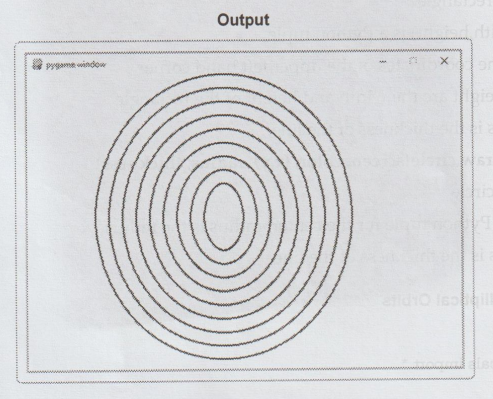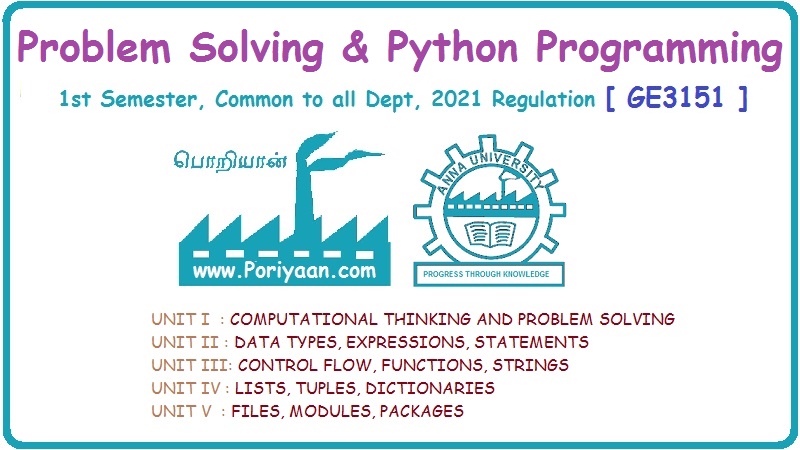Problem Solving and Python Programming: Laboratory Programs
Laboratory Python Programs Set 2
Problem Solving and Python Programming
Engineering Python : UNIT V : Files, Modules, Packages : Experiment and Solution
Experiment
11: Exploring Pygame tool
Solution :
Program
:
Before actual coding in Pygame, let us understand what is Pygame. Pygame is
basically a cross-platform set of Python modules designed for writing video
games. It includes computer graphics and sound libraries designed to be used
with the Python programming language.
We
can draw various graphics or we can create simple games using Pygame.
How
to Download Pygame ?
We
can download Pygame using following steps
Step
1:
Open the website http://www.pygame.org/download.shtml. Depending upon your
operating system, download appropriate version of Pygame. For my Windows
operating system, I have chosen following link

On
the web site http://www.lfd.uci.edu/~gohlke/pythonlibs
/#pygame search for Pygame, Since I am using Windows 32 bit and Python 3.6, I
have chosen the release marked as below

Get
it downloaded on your computer.
Step
2: For
installing this version, open command prompt and type the command
Prompt
:> pip install wheel
This
command will download required additional libraries.
Step
3:
Then type the command
Prompt
: > pip install wheel -upgrade
It
will display the message “Requirements already up-to-date"
Step
4:
Now change the directory on the command prompt window to the directory where
you have downloaded Pygame. Issue the command for installation

Finally
the Pygame gets successfully installed.
How
to write Pygame program ?
The
Pygame program can be written with the help of Python IDE. Open the new File
and write the code for Pygame program. You should save your code with .py
extension. The following is the simplest anatomy of writing any Pygame program
import
pygame
pygame.init()
screen
= pygame.display.set_mode((400, 300))
done
= False
while
not done:
for
event in pygame.event.get():
if
event.type == pygame. QUIT:
done
= True
pygame.display.flip()
Code
Explanation :
import
pygame - This is the most required statement at the
beginning of any Pygame program.
pygame.init()
-
It initializes all the modules required for PyGame.
pygame.display.set_mode((width,
height)) - This will launch a window of the desired size. The
return value is a Surface object which is the object you will perform graphical
operations on.
pygame.event.get()
-
This empties the event queue. If you do not call this, the windows messages
will start to pile up and your game will become unresponsive in the opinion of
the operating system.
pygame.QUIT
-
This is the event type that is fired when you click on the close button in the
corner of the window.
pygame.display.flip()
-
PyGame is double-buffered. This swaps the buffers. All you need to know is that
this call is required in order for any updates that you make to the game screen
to become visible.
When
we run the above code we will get

We
can draw rectangles, circles, ellipse and so on using various commands. Before
you draw any object fill the screen with suitable color.
screen.fill(color)
The
color is in the form of R,G,B values. For example
red
= (255,0,0)
green
= (0,255,0)
blue
= (0,0,255)
darkBlue
= (0,0,128)
white
= (255,255,255)
black
= (0,0,0)
pink
= (255,200,200)
Here
are the commands for drawing lines, rectangles, and so on
(1)
pygame.draw.lines(screen, color, closed, pointlist, thickness)
•
draws a series of lines, connecting the points specified in pointlist
•
pointlist is a list of tuples, specifying a series of points.
•
closed should be either True or False, indicating whether to connect the last
point back to the first
•
thickness is the thickness of the line (in pixels).
•
Example : pygame.draw.lines(screen, black, False, [(100,100), (150,200), (200,100)],
1)
(2)
pygame.draw.rect(screen, color, (x,y,width,height), thickness)
•
draws a rectangle
•
(x,y,width, height) is a Python tuple
•
x,y are the coordinates of the upper left hand corner
•
width, height are the width and height of the rectangle
•
thickness is the thickness of the line.
(3)
pygame.draw.circle(screen, color, (x,y), radius, thickness)
•
draws a circle
•
(x,y) is a Python tuple for the center,
radius is the radius
•
thickness is the thickness of the line.
Simulation
of Elliptical Orbits
import
pygame
from
pygame.locals import *
pygame.init()
screen
= pygame.display.set_mode((640,480))
white
= (255,255,255)
black
= (0,0,0)
screen.fill(white)
while
True:
for
event in pygame.event.get():
if
event.type = = QUIT:
pygame.quit()
pygame.draw.ellipse(screen, black,(260,160,60,100),2)#innermost ellipse
pygame.draw.ellipse(screen,
black,(240,140,100,140),2)
pygame.draw.ellipse(screen,
black,(220,120,140,180),2)
pygame.draw.ellipse(screen,black,(200,100,180,220),2)
pygame.draw.ellipse(screen,
black,(180,80,220,260),2)
pygame.draw.ellipse(screen,
black,(160,60,260,300),2)
pygame.draw.ellipse(screen,
black,(140,40,300,340),2)
pygame.draw.ellipse(screen,
black,(120,20,340,380),2)
pygame.draw.ellipse(screen,
black,(100,00,380,420),2)#outermost ellipse
pygame.display.update()
Output

Problem Solving and Python Programming: Laboratory Programs : Tag: Engineering Python : Problem Solving and Python Programming - Laboratory Python Programs Set 2
Related Topics
Related Subjects
Problem Solving and Python Programming
GE3151 1st Semester | 2021 Regulation | 1st Semester Common to all Dept 2021 Regulation
